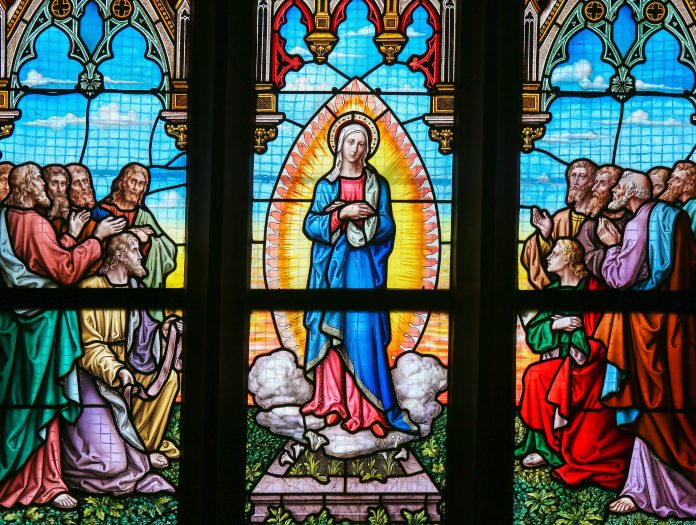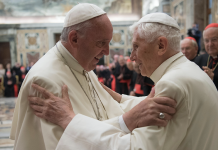
by William H. Johnston
See the end of this article for a more comprehensive Study Guide.
How do we discover the ways of prayer? We can learn at home from parents, at the parish from the liturgy or the parish staff, at school from teachers, under the guidance of a spiritual director, on our own from study, or simply by listening to the movements of our hearts as they turn to God in love. We can also learn from the riches of the Church’s tradition of prayer. From among many others, here are four sources from that tradition.
Benedictine
Saint Benedict (sixth century) is a leading figure in the history of monasticism and the founder of the Benedictine family of religious communities. A brief phrase that expresses the charism of monastic life is ora et labora, “pray and work.” This calls one to be devoted to God and to attend to the needs of self, community, and the wider world—a good recipe for a balanced life. At the heart of one’s daily rhythm of prayer is Scripture, in particular the Psalms—and this goes not only for Benedictines but for the whole Church in its daily prayer of the Liturgy of the Hours.
A method of praying with Scripture that developed in the monastic tradition is known as lectio divina, a phrase often translated as “sacred reading.” The method is ancient but remains fully relevant for us today.
Indeed, Pope Benedict XVI has called for renewed attention to lectio divina, saying that he is convinced it can bring the Church “a new spiritual springtime.” Its four parts can be practiced in various ways. The approach presented here is very simple. While useful for anyone, it is especially helpful for those new to lectio divina.
What follows is based on “A Monastic Primer,” found at the New Melleray Abbey website, where it is explained more fully and very beautifully.
The first step is reading (lectio). Beginning in a spirit of prayer, open your Bible to the passage you have selected and simply start to read. Read slowly. You are not in a hurry because your point is not to finish the reading but to let God speak to you, here and now, in and through the sacred text.
Then comes meditation (meditatio), sometimes referred to as repetition (repetitio). When a word or phrase grabs your attention and “speaks” to you, stop reading and simply stay with those words, prayerfully and slowly repeating them several times. No need to think about the text or draw lessons from it; just let God’s inspired Word do its healing, transforming work in you. Repeat the words in this slow, prayerful way for as long as they hold spiritual power. When that passes, return to the first step and continue reading.
During this process, you sometimes will be drawn to offer God a brief word of prayer. This is the third component (oratio). Perhaps the phrase you are meditating on leads you to say to God, in some way, “Thank you for…” or “I’m sorry that…” or “Please help me to….” Such prayers may be very brief; then return to the reading or meditation.
At times, this process may lead to an inner silence. Here, no words are used and no thoughts are thought. You simply are present with the Lord in a wordless, loving communication. This is a form of “contemplation” (contemplatio), a fourth aspect of lectio divina. Stay with this prayer as long as it lasts—perhaps just a few seconds or minutes. When it ends, return again to the reading or meditation.
The regular practice of sacred reading will fill your mind and heart with a treasure trove of scriptural passages that can nourish your spirit with the power of God’s word. This is an especially fitting method of prayer for catechists who serve as ministers of God’s word.
Dominican
Saint Dominic (thirteenth century) devoted his life to preaching the gospel. To be prepared for this ministry, Dominic and his followers devoted themselves to study. Of the various features of Dominican spirituality that we might highlight, let us focus here on this Dominican commitment to study, which they practice not as something alongside and separate from their prayer and spirituality but as a form of it. There is a true “spirituality of study” that all can cultivate—not only in preaching but in all forms of teaching and catechesis.
Anyone who teaches would want to learn more about those they teach (the learner), how to teach (the process of learning), and what they teach (their subject matter). A way to “pray” our studying of any of these topics is to begin and conclude times of study with moments of prayer, for ourselves that we may gain insight and wisdom, and for our students that they may benefit thereby.
But beyond this, the very act of studying and exercising the intellect God gave us in service to the welfare of others can become prayer. This happens when the time spent in study is also infused by the sheer joy of learning, and by our love—of the students we teach, of the subject we teach, of the knowledge and truth we seek to hand on, and of the Truth to whom we seek to lead our students, namely, Christ himself (John 14:6).
The more catechists can devote time to study in a spirit of prayer, the more their own catechist spirituality will be deepened and renewed.
Ignatian
Saint Ignatius Loyola (sixteenth century), founder of the Society of Jesus, or Jesuits, was a master of the spiritual life because he reflected deeply on the ways he experienced God’s love for him and learned how to discern God’s presence and movement in his life. He became uniquely gifted in being able to guide and help others who sought to know God’s love and hear God’s call in their lives. The 30-Day Retreat is perhaps the most famous way the Ignatian practice of discernment is carried on in the Church today.
For those unable to take a month for such a retreat, there are other options. One is called the Nineteenth Annotation, where one does the retreat at home over the course of nine months or so, devoting an hour and a half each day to prayer and meeting with a retreat director weekly.
There is also an eight-day format that provides an abbreviated experience of the 30-day retreat; for many, this opportunity can prove to be a time of rich blessings and even a turning point in their relationship with God. Even a weekend of prayer at a Jesuit retreat house provides a nourishing taste of what these longer retreats offer.
An Ignatian practice that anyone can use, and that St. Ignatius recommended highly, is the daily examen. It takes about 15 minutes (less if need be), typically at the end of the day. The basic steps are these. First, let yourself be still and come to rest in the presence of God. Then recall God’s many good gifts to you, especially those of this particular day, and be thankful.
Second, pray that God enlighten your vision and memory to give you a Holy-Spirit-guided perspective on your life, and then ask yourself two questions.
1. How was God present and active in my life today? Some people review their day like they were watching a movie, while others just let moments arise to consciousness as they will. Either method works. As you recall what happened, then ask yourself:
2. How did I respond to God’s presence today? See what moments in the day draw your attention. Be honest—and talk with God about how things went. In a way, this is the heart of the daily examen. What do you learn in this conversation with God?
Third, for the times you may have neglected God’s call, were slow to respond, or were sinful, ask for God’s merciful forgiveness and for healing and strength to be able to respond in a more faithful and loving way in the future. Then look forward to tomorrow, asking for God’s presence and guidance in a spirit of hope and trust.
Careful and prayerful meditation of this kind each day will help one become more attuned to God’s movement and faithful to God’s call in life.
Eastern Catholic Spirituality
John Paul II often said that the Church would be healthier if we breathed from both lungs—that is, from the Christian traditions of East and West. If we took his advice, those of the Western tradition (such as Roman Catholics) would try to learn something from those of the Eastern tradition. Doing so might lead us to a deeper value of silence, the beauty of the liturgy, or praying with icons.
Here let me recommend a form of prayer more commonly practiced in the Christian East, often known as the Jesus Prayer. I first learned of this prayer in my college days by reading R. M. French, The Way of a Pilgrim (a book still in print, in various editions), which tells of the journeys of a Russian peasant in the nineteenth century, and of the prayer he learned and its impact on his life.
The prayer can be as short as two words, “Jesus . . . mercy.” But its long form is “Lord Jesus Christ, Son of the Living God, have mercy on me, a sinner.” The prayer is valued so highly because it uses the holy name of Jesus (e.g., Galatians 1:3) and the words of Scripture (see Luke 18:13, also 18:38); because it contains the heart of the gospel message of God’s great mercy; and because its use can fulfill the biblical injunction to “pray without ceasing” (see Luke 18:1; 1 Thessalonians 5:17, Romans 12:12).
The prayer is used by being repeated. Under the guidance of a staretz, or spiritual director (which is sometimes still recommended as the way to learn it), the peasant began repeating the prayer a few times each day, gradually increasing until he was saying it several thousand times a day. What might happen eventually, as it did to him, is that the prayer “sinks” from the lips and the mind into the heart and becomes what is called “self-actualizing.” It is as though the prayer goes on praying, even without one being conscious of it; once in a while (as when one awakes in the morning or there is a pause in one’s thinking during the day) a moment occurs and one realizes, “Oh, that’s the Jesus Prayer.” Thus, prayer without ceasing.
This is a prayer one can use during personal prayer time, simply praying the words slowly in the manner of lectio divina as described above. One could also use the beads of a rosary to pray the prayer in sets of 50. One can use the prayer in other settings as well—for example, while walking, as a way of becoming accustomed to the prayer. Just match the rhythm of the stride with the rhythm of the phrases of the prayer. It can work like this. Left stride (“Lord”), right stride (“Jesus”), left (“Christ”), right (pause), left (“Son of the”), right (“Living”), left (“God”), right (pause), left (“have mercy on”), right (“me”), left (“a sinner”), right (pause); then repeat. With a little practice it becomes quite natural. Does it sound a little strange? Well, what do you do while walking? Why not pray?
As the Catechism of the Catholic Church says, “By a living transmission—Tradition—the Holy Spirit in the Church teaches the children of God to pray” (n. 2661). May these and the many other sources from our tradition offer you and your students rich and varied guidance in the ways of prayer.
Dr. Johnston is Assistant Professor in the Department of Religious Studies at the University of Dayton where he teaches courses related to pastoral ministry. He has held parish and archdiocesan catechetical positions, directed a diocesan ministry formation program, and chaired the board of NALM.
Study Guide
This is the second article in our series titled “Spirituality: Grounding in the Mystery of God.” Dr. Johnston introduces us to four significant schools of spirituality: Benedictine, Dominican, Ignatian, and Eastern Catholic spirituality. Each school offers a unique approach to prayer, and Dr. Johnston briefly describes examples for practicing each prayer form. Many people do not realize the wealth of prayer forms that have been cultivated within the Church throughout history. As catechists, we are called to introduce our students to the Church’s treasury of wealth and wisdom within our Catholic tradition.
Discussion/Reflection Questions
1. Praying is more than simply saying prayers. How did I learn to pray? What have I learned about praying?
2. What has been my experience with lectio divina? How do I incorporate lectio divina into my prayer life? What benefits have I realized with this prayer form?
3. Do I understand “study as a form of spirituality”? What percentage of my week is dedicated to studying Scripture, Church teaching, the lives of the saints, and more? What have I learned from my study? How might I set aside time to incorporate “study as a form of spirituality” in my routine, as expressed in the Dominican tradition?
4. How do I discern and practice God’s presence and movement in my life? How does the sense of God’s presence impact living each moment of my life? What might I consider for enhancing a more radical sense of God’s presence each day?
5. What has been my experience of the Ignatian daily exam? If none, how might I consider integrating this prayer form into my life?
6. What did Pope John Paul II mean by “the Church would be healthier if we breathed from both lungs”?
7. What is the Jesus Prayer? How might I integrate this prayer into my life?
8. What have I learned concerning schools of spirituality as a treasure of Catholic Tradition?
9. What has been my most significant learning in reading and reflecting on this article? How does it connect with the September article by Fr. Heft (go to catechist.com, Support for Catechists, Article Archive, and search author Heft)? What would I like to learn more about regarding spirituality?
Exercises
1. Review the steps described in Johnston’s article for practicing or exercising lectio divina. Design a lesson or unit plan for introducing this prayer form to your students.
2. Begin practicing lectio divina a few times each week. Note the difference that begins to emerge in your spiritual life and professional life.
3. Applying the Dominican approach of study as prayer, how can you introduce the idea to your students in order to stimulate their appreciation for the value of study as an expression of spirituality? (Be specific.)
4. If you have not been on a retreat, make a resolution to participate in one the coming year.
5. Prepare a lesson for demonstrating and guiding your students through the Ignatian daily exam prayer. Discuss why the daily exam is a holy way of living.
6. Prepare a series of lesson plans or create several prayer experiences that demonstrate the various prayer forms identified in Johnston’s article.
7. Have students do research and develop a PowerPoint presentation on the schools of spirituality addressed in Johnston’s article.
Related Reading
Gallagher, Timothy M. The Examen Prayer: Ignatian Wisdom for Our Lives Today. New York, NY: Crossroad Publishing Co., 2006.
Maas, Robin and Gabriel O’Donnell, O.P. (eds.). Spiritual Traditions for the Contemporary Church. Nashville, TN: Abingdon Press, 1990.
Murray, Paul. The New Wine of Dominican Spirituality: A Drink Called Happiness. London/New York, NY: Burns & Oates, 2006.
New Melleray Abbey. “A Monastic Primer.” Go to newmelleray.org and find it under “Site Map.”
Raab, Christian, OSB, and Harry Hagan, OSB. (eds). The Tradition of Catholic Prayer, by the Monks of saint Meinrad. Collegeville, MN: Liturgical Press, 2007.
The Way of a Pilgrim is available in several editions.
Copyright 2011, Bayard, Inc. All rights reserved. This article is protected by United States copyright and other intellectual property laws and may not be reproduced, rewritten, distributed, redisseminated, transmitted, displayed, published or broadcast, directly or indirectly, in any medium without the prior written permission of Bayard, Inc.
This article was written by the Catechist Staff and appeared in Catechist magazine, September 2011.
Image Credit: Shutter Stock 506725372




